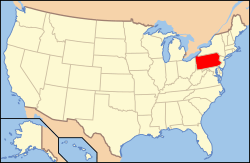Upsala (mansion)
Upsala is a historic mansion in Mount Airy, Philadelphia, Pennsylvania, United States. Considered one of the finest extant examples of Federal architecture, the mansion is a contributing property of the Colonial Germantown Historic District and is listed on the National Register of Historic Places[1] and the Philadelphia Register of Historic Places.
Upsala | |
U.S. National Historic Landmark District Contributing Property | |
 Upsala, October 2009 | |
   | |
| Location | 6430 Germantown Avenue Germantown Philadelphia, Pennsylvania United States |
|---|---|
| Coordinates | 40°2′48.15″N 75°8′8.28″W |
| Area | < 1-acre (4,000 m2) |
| Built | 1798-1801 |
| Architectural style | Federal |
| NRHP reference No. | 72001174[1] |
| Added to NRHP | January 13, 1972 |
During the 1777 Battle of Germantown, American troops gathered on the site before attacking British forces across Germantown Avenue at Cliveden, Benjamin Chew's mansion.[2]
History
In 1698, the first owner of the property, Heivert Papen, built a small house on the corner of present-day Johnson Street and Germantown Avenue.[3] The land passed to Dirck (or Dirick) Jansen, one of Germantown's earliest settlers, and was purchased in 1766 by John Johnson, Sr., son of the builder of the nearby John Johnson House.
The property was a staging ground of the Continental Army at the Battle of Germantown on October 4, 1777. Continental cannons were placed on the front lawn, and fired at Cliveden (Benjamin Chew House).
John Johnson, III inherited the property in 1797 and built Upsala Mansion.[4] Raised as an English-speaking Quaker, Johnson married Sally Wheeler in 1801, and together they had nine children at Upsala. The building may have been named after the Swedish city of Uppsala, though that is unconfirmed. There is additional speculation that one of the Johnson family members was quite taken with, and subsequently named the house after, the Swedish author, Fredrika Bremer.
The small house built by Papen was demolished in 1883.[5]
In the 1920s, the annual Revolutionary Germantown Festival began re-enacting the Battle of Germantown, including the attack from Upsala Mansion to Cliveden, on the first Saturday of October.[6]
Upsala Mansion was owned and occupied by the Johnson family until 1941. Dr. William Johnson, chief of staff of Germantown Hospital, died deeply in debt. In 1941, the property was seized from his widow, Sarah Trowbridge Bartow Johnson.
In September 1942, the property was vandalized, and the roof was heavily damaged by fire.[7] The property was put up for auction and the mansion slated for demolition. There were talks about building a supermarket on the site.
In 1944, a group of local preservationists led by Frances Anne Wister acquired the house and established a foundation to restore the property. The building was added to the National Register of Historic Places January 13, 1972.
The house operated as a museum until the early 2000s, when the museum closed due to lack of visitors. The Upsala Foundation merged with Cliveden, which managed the property in cooperation with the National Trust for Historic Preservation. In 2016, they put the property up for sale.[8]
The house was sold to two preservation-minded millennials, Alex Aberle and Violette Levy, who are converting the house from a museum back into a single family home. To secure the deal, the new owners agreed to allow the annual battle re-enactment.[9]
References
- "National Register Information System". National Register of Historic Places. National Park Service. January 23, 2007.
- "National Register of Historic Places Nomination Form: Upsala" (PDF). dot7.state.pa.us. Pennsylvania Historical and Museum Commission. 1971.
- Hotchkin, Samuel Fitch (1889). Ancient and Modern Germantown, Mount Airy and Chestnut Hill. P. W. Ziegler & Company. p. 283.
- Eberlein, Harold Donaldson; Lippincott, Horace Mather (1912). The Colonial Homes of Philadelphia and Its Neighbourhood. J. B. Lippincott Company. p. 255. Retrieved January 4, 2014.
- "Johnson House, Main & Johnson Sts. Oldest house in Germantown. Built in 1698 by Heivert Papen. Passed into Johnson family early in the 18th century. Demolished in 1883. [graphic] / John G. Bullock. | Library Company of Philadelphia Digital Collections". digital.librarycompany.org. Retrieved 2019-02-05.
- Wallace, Carolyn. "| Battle of Germantown 2018". Retrieved 2019-02-05.
- "Fire Damages Mansion". Bradford Evening Star. 1942-09-17. Retrieved 2017-01-15.
- Romero, Melissa (2016-09-21). "Historic Upsala on American Revolutionary site lists for $499K". Curbed Philly. Retrieved 2019-02-05.
- Farr, Stephanie. "Couple's historic Philly home came with an unusual caveat: Annual battle reenactments | We the People". https://www.philly.com. Retrieved 2019-02-05. External link in
|website=(help)
Further reading
- Marion, John Francis. Bicentennial City: Walking Tours of Historic Philadelphia. Princeton: The Pyne Press, 1974.
- Minardi, Joseph M. Historic Architecture in Northwest Philadelphia: 1690-1930s. Atglen, PA: Schiffer Publishing, 2011.
- Moss, Roger W. Historic Houses of Philadelphia: A Tour of the Region's Museum Homes. Philadelphia: Univ. of Pennsylvania Press, 1998.
- Tinkcom, Harry A. and Margaret B. and Grant Miles Simon, Historic Germantown: From the Founding to the Early Part of the Nineteenth Century. Philadelphia: The American Philosophical Soc., 1955.
External links
| Wikimedia Commons has media related to Upsala (Philadelphia, Pennsylvania). |
- Official website
- Historic Upsala Instagram
- Historic Upsala Facebook
- Article at UShistory.org
- Listing at Philadelphia Architects and Buildings
- Historic American Buildings Survey (HABS) No. PA-1718, "Upsala", 3 photos, 1 photo caption page, supplemental material

